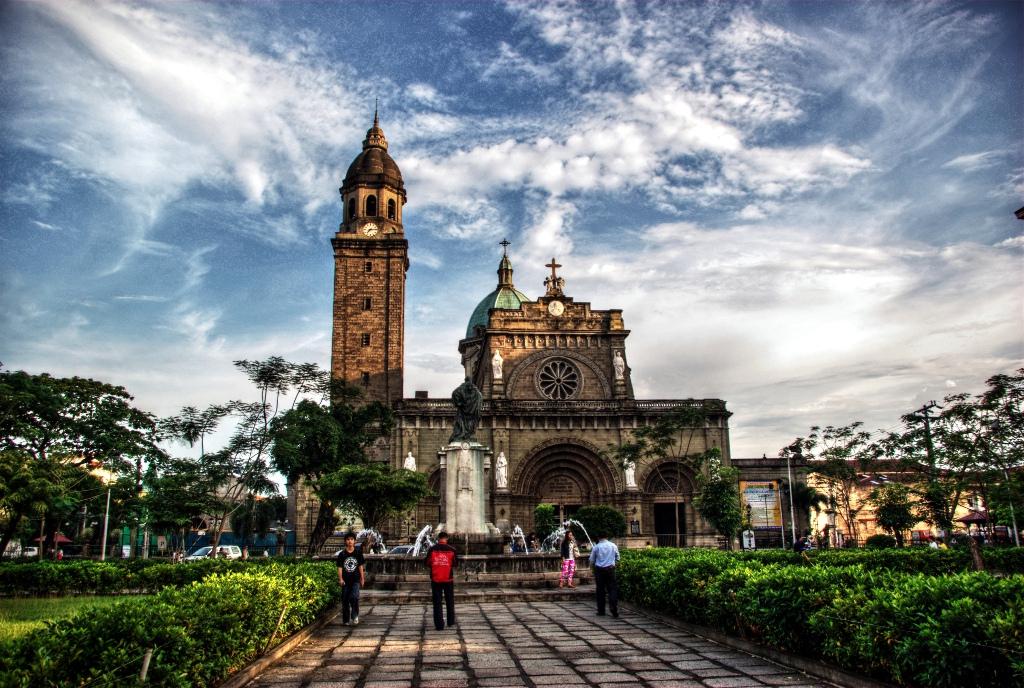
The Manila Metropolitan Cathedral-Basilica (also known as the Cathedral-Basilica of the Immaculate Conception and informally as Manila Cathedral) is a prominent Latin Rite Roman Catholic basilica located in Manila, Philippines, honoring the Blessed Virgin Mary as Our Lady of the Immaculate Conception, the Principal Patroness of the Philippines.
Located in the Intramuros district of Manila, it was originally a parish church owned and governed by the diocese of Mexico in 1571, until it became a separate diocese on February 6, 1579 upon the issuance of a Papal bull by Pope Gregory XIII.
The cathedral serves both as the Prime Basilica of the Philippines and the highest seat of the archbishop in the country. The cathedral was damaged and destroyed several times since the original cathedral was built in 1581. The eighth and current incarnation of the cathedral was completed in 1958.
The Basilica has merited three Papal endorsements and two Apostolic visits from Pope Gregory XIII, Pope Paul VI, and Blessed Pope John Paul II, who through the papal bull Quod Ipsum declared the cathedral a minor Basilica by his own Motu Proprio on April 27, 1981.
The current-elect for the Apostolic Papal Nuncio of the Philippines is Archbishop Giuseppe Pinto. The cathedral serves as the highest seat of the Roman Catholic Archdiocese of the Philippines, while the present Archpriest of the Basilica-Cathedral is Archbishop Luis Antonio Tagle, the de facto Primate of the Philippines.
Blessed Virgin Mary as Principal Patroness
Consecrated by Pope Pius XII's Papal Bull Impositi Nobis in 1942, the Immaculate Conception is honored as the Principal Patroness of the Basilica.
In 1581, Pope Gregory XIII issued a papal bull consecrating the cathedral building to La Purisima Inmaculada Concepcion de Maria, while Miguel Lopez de Legaspi consecrated the city of Manila to Saint Potenciana. In 1942, Pope Pius XII rededicated the Filipino people to La Purisima Inmaculada Concepcion through a Papal Bull called Impositi Nobis, while Saint Rose of Lima and Saint Potenciana remained as the secondary patroness of the Filipino people. The Latin declaration came in the Acta Apostolicae Sedis from January 20, 1942.
Details of the Shrine
The main façade is a replica of the original façade of the previous cathedral, along with statues of famous saints sculpted in Roman travertine stone. In the previous cathedral, they were originally made of molave wood. The statue of St. Rose of Lima was sculpted by Angelo Fattinanzi while Saint Jacob, Saint Andrew, St. Anthony the Abbott were done by sculptress Livia Papini; St. Francis Xavier and St. Polycarp were sculpted by Alcide Tico.
The front facade (tympanum) of the cathedral has a notable Latin inscription which reads: Tibi cordi tuo immaculato concredimus nos ac consecramus. (English: We consecrate to your immaculate heart and entrust to you (Mary) for safekeeping.)
Since Blessed Pope John Paul II's Apostolic Visit to the basilica in 1981, a grand logo of the Papal Keys and Papal Tiara have been prominently featured on the top-front facade of the cathedral. The red galero hat of Cardinal Rufino Santos is also hoisted on the ceiling of the dome of the cathedral. In addition, a Roman copy of the Saint Peter's seated statue from St. Peter's Basilica is enshrined inside, along with a life-sized statue of the Immaculate Conception. Prior to 1985, the statue of the Immaculate Conception in the main altar was painted in gold. An antiphon inscription on the baldachin above the statue of the Immaculate Conception reads: Tota Pulchra es Maria et Macula Originalis Non est in Te (English: Mary is All-Beautiful and the Original Sin is Not in You).
Accommodations
- Bayview Park Hotel - Ermita, Manila
- Centara Hotel Manila - Malate, Manila
- Century Park Hotel - Malate, Manila
- Diamond Hotel Manila - Malate, Manila
- G Hotel Manila by Waterfront - Malate, Manila
- Hotel H20 Manila - Rizal Park, Manila
- Hyatt Hotel and Casino Manila - Ermita, Manila
- Manila Hotel - Rizal Park, Manila
- Pan Pacific Manila - Malate, Manila
- Ramada Manila Central - Binondo, Manila
- The Bayleaf Intramuros - Intramuros, Manila
- Waterfront Manila Pavilion - Ermita, Manila
Getting around the Manila City
Manila is the major city in the Philippines. Tourists can go around Manila in many options. Buses, FXs, jeepneys, taxis, tricycles, and pedicabs are available as a mode of transportations in the city. The city is also serviced by the Manila Light Rail Transit System, popularly known as LRT, as distinct from the MRT in other parts of Metro Manila.
Calesas are still used in the streets of Binondo and Intramuros, but mostly for tourists. Which mode of for-hire used depends upon the distance to be traveled, the cost, and the width of the streets.
The Port of Manila, located in the vicinity of Manila Bay, is the chief seaport of the Philippines. The city is also served by the Pasig River Ferry Service which runs on the Pasig River.
The city is served by the Ninoy Aquino International Airport and Diosdado Macapagal International Airport.










